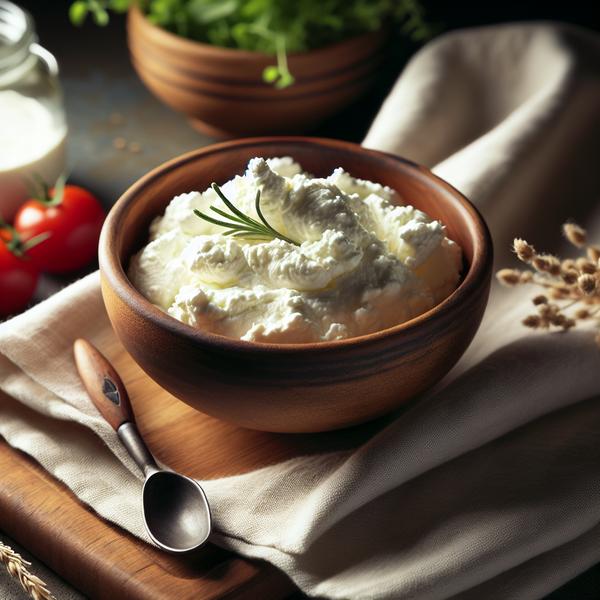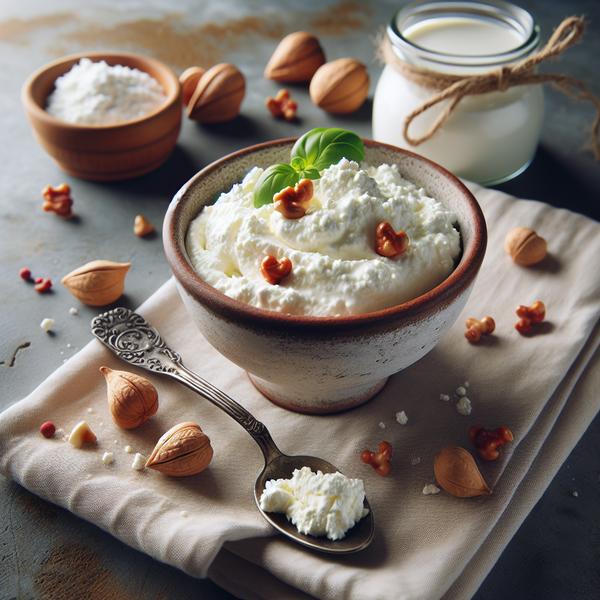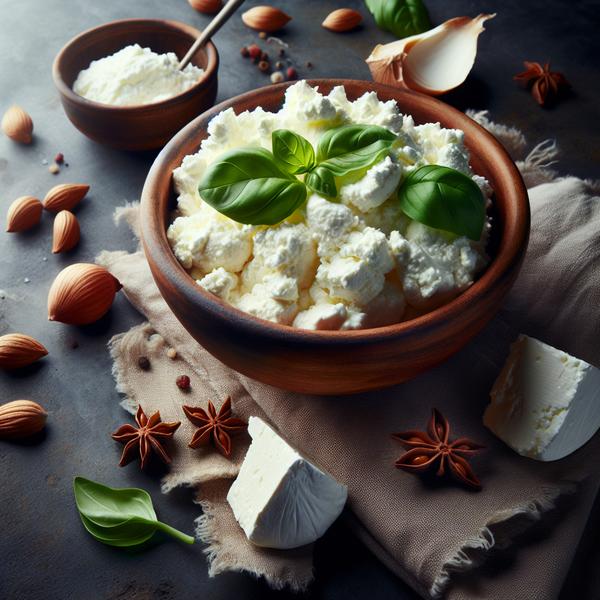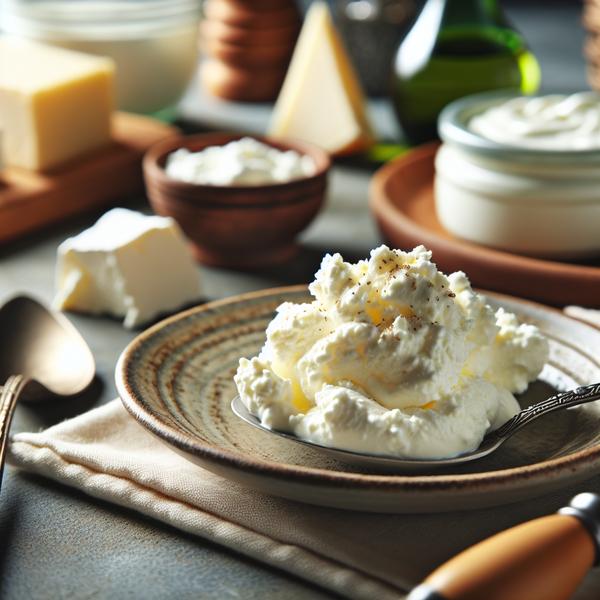What Is Ricotta Cheese? (Understanding Its Delicious Taste)

Want to know what the heck ricotta cheese is?
Have you ever stared at a menu and wondered, "Is that a fancy type of cottage cheese?" 😮
Girl, I feel you!
But fear not, my friend.
Let's unravel the mystery together and unleash our inner cheese connoisseurs.
Let's dive in!
What Is Ricotta Cheese?
Ricotta cheese, a popular Italian staple, is a fresh whey cheese made from the liquid byproduct of cheese production. With its high moisture content, ricotta is known for its creamy and delicate texture.
Originating in Italy, ricotta has been a favorite in Italian cuisine for centuries.
But let me tell you something:
Ricotta cheese is not your typical cheese. It's not like cheddar or gouda that you slice and eat on its own.
You won't find it on a cheese board either.
No way, my friend.
Ricotta is a versatile beast.
The thing that sets it apart from others is its creamy and delicate texture.
It's so smooth and luscious that it practically melts in your mouth.
Seriously, it's like eating a cloud made of cheese.
Trust me, once you try it, you'll be hooked.
You might be thinking, Well... What can I do with ricotta cheese?
Good question, my curious friend.

There are endless ways to use ricotta in your culinary adventures.
First things first, ricotta shines in Italian desserts.
Ever heard of cannoli?
That sweet treat filled with creamy goodness?
Yep, ricotta cheese is right there in the filling.
It adds a rich and indulgent flavor that will make your taste buds sing.
But ricotta isn't just for sweets.
Oh no, it's incredibly versatile in savory dishes too.
Spread it on toast for a quick and delicious breakfast.
Mix it with herbs and spices to create a flavorful dip.
Or layer it in lasagna for a creamy and cheesy delight.
The possibilities are endless, my friend.
So why not give ricotta cheese a try?
It's a unique cheese, and once you taste its creamy goodness, you'll wonder how you ever lived without it.
Main points I'll expand upon further down this article:
- Ricotta cheese can be made from the milk of cows, sheep, goats, or water buffalo.
- Using whole milk instead of whey is possible for modern ricotta production.
- Ultra-pasteurized milk should be avoided, and whole milk is preferred for a richer taste.
- Ricotta is generally made by curdling whole milk with an acid.
- Traditional ricotta involves heating whey along with whole milk and vinegar or citrus juice.
- Ricotta cheese is a light, spongy, and creamy fresh cheese with a soft curd texture.
- Ricotta cheese is versatile and can be used in both sweet and savory dishes.
- Different types of milk can be used to make ricotta, and there are various variations and uses for it.
But I bet you're wondering, what's the difference between ricotta cheese and another soft cheese like cottage cheese?
Trust me, you'll be surprised by their unique characteristics!
The Distinctions Between Ricotta and Cottage Cheese
Ricotta and cottage cheese may have a similar appearance, but you ought to understand that they are different.
To begin with, ricotta is produced using the whey left over from cheese production, whereas cottage cheese is derived from cow's milk. These distinct sources result in contrasting flavors.
And that's not all...
Cottage cheese boasts a unique texture due to its curds, which can range in size from large to small.
On the flip side, ricotta has a softer and smoother consistency, resembling a delightful creamy indulgence.
But here's another noteworthy point...
Cottage cheese is often considered to be akin to ricotta, sharing some common characteristics while maintaining their individual traits.

Therefore, if you desire a cheese with either large or small curds and a mild taste, it would be worth trying out cottage cheese.
Alternatively, if you prefer something lusciously smooth and creamy on your palate, give ricotta a shot.
Ultimately, discovering the cheese that caters to your specific preferences is a matter of personal choice.
Now that we understand the differences between ricotta and cottage cheese, let's delve into the intriguing process of making traditional ricotta.
Have you ever wondered how this creamy delight is created, and why it's called recooked?
Allow me to share the fascinating details with you.
Step into the world of whey cheese as I unveil the secrets behind the production of fluffy, rich ricotta!
The Art of Ricotta Cheese Making
Ricotta cheese is a creamy, white cheese made by heating whey and whole milk with vinegar or citrus juice. It can be made from different animals, but cow's milk is most common. The mixture is strained, resulting in a fluffy, pure white cheese.
However, nowadays, we can use whole milk instead of whey in modern ricotta production.
Just keep in mind that ultra-pasteurized milk should be avoided because it can affect the flavor.
In countries like the United States, ricotta cheese is typically made by curdling whole milk with an acid.
They use the leftover whey from making other cheeses to produce ricotta.
It's interesting to note that the name ricotta comes from the Italian word for recooked, which refers to the high temperature used during whey processing (around 185-195°F).
Now, let me share a little secret that will revolutionize your cheese game! 😄

Pay attention!
To make ricotta cheese at home, you'll need milk, heavy cream, salt, and vinegar or lemon juice as a substitute.
It's a simple recipe that yields a deliciously rich and creamy cheese perfect for various dishes.
Here's how you do it:
- Heat the milk and heavy cream together in a large pot over medium heat. Slowly bring it to a gentle simmer, stirring occasionally to prevent it from burning.
- Once the mixture starts to simmer, add the vinegar or lemon juice and gently stir until you see the cheese curds forming. Let it cook for a few minutes more.
- Take a colander and line it with cheesecloth, placing it over a bowl to catch the whey. Carefully pour the cheese mixture into the colander, allowing the whey to strain through. Remember, the longer you let it drain, the drier the cheese will become.
- After about an hour, gather the edges of the cheesecloth and gently squeeze out any remaining liquid. Transfer the cheese to an airtight container and refrigerate until you're ready to use it.
Now that you've mastered the art of making ricotta cheese, think about all the possibilities!
Use it in lasagna, stuffed shells, or even spread it on some crusty bread.
Homemade ricotta's creamy texture and delicate flavor will enhance any dish you create.
But wait, there's more to ricotta cheese.
Let me tell you all about its mouthwatering texture and versatile flavor...
What Does Ricotta Cheese Taste Like?
Ricotta cheese is a powerful contender.
You're wondering, what's the taste like?
Picture a light, airy cheese floating on your tongue.
Soft and silky, its delicate curds create a thrilling exploration for your palate.
And guess what?
Ricotta cheese provokes a mouthwatering sensation.
It has a mild creaminess with a subtle hint of nuttiness.
You could even argue it's the best of both worlds.
But wait!

There's more.
This cheese isn't just excellent alone.
No way, my friend.
Ricotta cheese is adaptable. It collaborates effortlessly.
It heightens the flavors of both sweet and savory dishes.
So whether you crown a lasagna or plop a spoonful onto pancakes, ricotta cheese brings a blissfully textured mouthfeel that will keep you craving for more.
In fact, ricotta cheese is so astonishing that it may quickly become your new food fixation. And who can blame you?
It's absolutely delectable. 😋
And it gets better.
Not only is ricotta cheese a delight on its own, but it also serves as an essential and versatile ingredient in countless dishes:
What Can Be Made With Ricotta Cheese?
You gotta love ricotta cheese.😍
It's like a little powerhouse of possibilities. Here are 12 killer ways you can incorporate this creamy goodness into your recipes and meals, my friend:
- Think lasagna, stuffed shells, and pizza toppings – the classics.
- Whip up some savory dips with your favorite herbs or spices.
- Need a sweet and tangy snack? Try fruit and honey crostini with that delicious ricotta.
- Ditch the cream cheese and slather ricotta on your toast for a creamy twist.
- Give yogurt the old heave-ho and add ricotta for some extra creaminess in your recipes.
- Forget mayo in those sandwiches, amigo. Swap it out with ricotta for a healthier twist.
- Amp up the richness factor in your grilled cheese by adding some velvety ricotta.
- Take your herb-infused dips to a whole new level of yumminess with a dollop of ricotta.
- Dessert time! Pancakes and cheesecakes just got a whole lot better with some ricotta action.
- Tomato pasta craving? Sprinkle some ricotta on top for that luscious creaminess factor.
- Waste not, want not. Use leftover whey from your ricotta to make your baked goods even more incredible.
- Last but definitely not least, Neapolitan pastiera pie during Easter. Ricotta brings all the creamy dessert fillings and depth of flavor to this bad boy.
Trust me, ricotta cheese is an absolute game-changer in your kitchen.

You need it.
And if you're wondering what other delicious cheeses you can substitute, look no further.
In my What Is Taleggio and Its Substitutes article, you'll find all the alternatives you need.
Different Varieties of Ricotta
Ricotta cheese comes in many flavors and textures, depending on the milk:
- Goat's Milk Ricotta: Made with goat's milk instead of cow's milk, this one has a tangy taste that goes well with sweet or savory dishes.
- Sheep's Milk Ricotta: Using sheep's milk gives it a creamy texture with a touch of sweetness, perfect for spreading on bread or crackers.
- Buffalo Milk Ricotta: This ricotta is extra velvety and decadent due to its higher fat content, ideal for indulgent desserts like cheesecake or cannoli filling.
- Ricotta Salata: Aged ricotta that has a stronger flavor and crumbly texture. Grate it over pasta or salads to add some saltiness.
- Ricotta Infornata: Baked ricotta becomes denser, great for slicing on crostini or adding to baked dishes like lasagna.
- Smoked Ricotta: Smoky flavor infused into the ricotta adds depth to omelets, pizzas, or pasta bakes.
- Aged Ricotta Forte: With a harder texture like Parmesan cheese, aged ricotta can be grated or used as a garnish for cooking.
No matter if you eat it fresh or store it long-term, ricotta cheese offers endless possibilities to incorporate its unique flavors and textures into your culinary creations. ✨
And it only gets better because in the next section, I'll walk you through the simple delight of making homemade ricotta cheese with just a few pantry ingredients.
Get ready to unlock the secret to creating your own creamy and flavorful ricotta right at home!
How to Make Homemade Ricotta Cheese
For making homemade ricotta cheese, you only need a few ingredients like milk, cream, salt, and vinegar. It's an easy delight!
To ensure everything goes smoothly, using a non-reactive pan is recommended.
This special pan helps in the curdling process, resulting in perfect homemade ricotta cheese.
Just combine the milk, cream, and salt in the pan, heat it up, then add vinegar to facilitate curdling.
That's it - simple and delicious homemade ricotta cheese awaits!
And that's all for today folks.
If you're looking for more of my helpful articles, you might want to take a peek at these: What Is Yuzu Fruit, Mozzarella With Reduced Moisture, Vegan Sausage Comprehensive Handbook, and Cheese Curds Explained
Until next time,
-Bianca Rossi